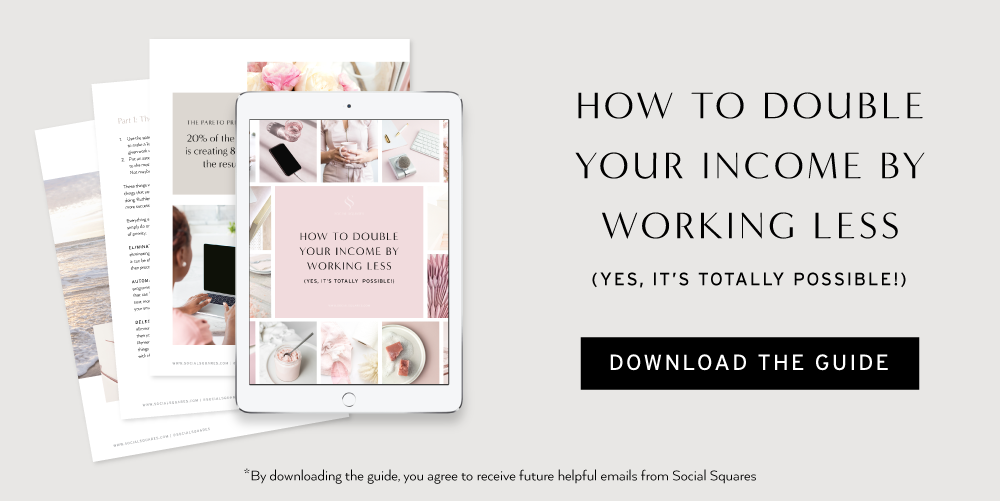My husband is an avid fan of the 4 Hour Work Week by Tim Ferriss and figuring out the minimum effective dose for getting something accomplished well.
Over 10+ years of being an online business owner in the audio industry and now as an online business coach to other aspiring business owners, he has learned how to 80/20 just about every aspect of life (including how much of my plant-based dinners he’s willing to eat).
He has a popular and controversial piece of content where he calls out business owners who elevate “hustling” and makes the bold claim the “Hustle is laziness in disguise”.
Think about it for a minute.
If you give yourself open-ended work hours you are highly likely to lazily fill it in with all kinds of time sucks like social media scrolling, inbox monitoring, and Facebook rabbit trails and somehow still get to the end of the day without having completed your ever-growing to-do list.
Parkinson’s Law argues this point another way and says that work expands to fill the amount of time allotted to it.
Give it 40 hours and it will take 40 hours to complete. Give it 16 and somehow you will get it done in 16.
Graham argues that it takes no real effort to just try and push and push and do “all the things” we see everyone else doing in business, filling up our days with work-for-work sake. It’s actually harder (initially) to stop, think, and assess what activities are actually strategic and generate revenue/growth in your business – and then ONLY doing those things.
Not only will it take you less time because you are actually doing less (but more strategic work) but by adding shorter deadlines and false time boundaries, the power of focus is on your side and you become ultra-productive.

Here’s the secret sauce that you came for…There are three reasons why I am able to run a now multi-six-figure business in 16 hours a week. You ready?
- I say “no” a lot (to myself, to others, to great opportunities, etc. etc.)
- I outsource and delegate a lot of what needs to be done. I didn’t always have a team but as the business has grown to the point it is at now, the choice was either I work more than 16 hours or I stay at my 16-hour schedule that I love and hire others to help make the business run.
- I have figured out my highest contribution to the business and I carve out my workday to do ONLY the most valuable and profitable work.
This last one is the one that we are going to focus on as we wrap up this series today.
The reason being, that it is the most powerful and effective way to grow your business and maintain balance and sanity and is absolutely essential to having work boundaries that still enable your business to be wildly successful.
You HAVE to discipline yourself to spend your time doing your most critical work and ruthlessly cut, outsource or delegate the rest.
This is true at almost every level of business.
Sure, in the early days you wear ALL of the hats out of necessity but the difference between businesses that grow out of this season and those that just get stuck in endless overwork with little profitability to show for it is business owners who learn how their time is best spent and do just that.
I can’t overemphasize this enough. It doesn’t matter what level of business you are at right now – You can start this TODAY and see improvements in profitability AND your sanity.
Prioritize your workday with a specific block schedule
- Raise your hand if you have ever had a workday upended because a child needs to be picked up from school sick?
- Raise your hand if you have ever felt so overwhelmed with the to-do list that you just clean out your desk drawers and answer e-mails instead?
- Raise your hand if you feel like you are always working on the urgent things in your business and never get time to get to the big important work ON your business?
I’ve been there too. Many times.
I have such limited windows of work time (6 hours on Tu/Thurs and 4 hours of Fridays) and I run two businesses and manage multiple employees and contractors in that very small window of time – not to mention needing to actually create the stock images that we sell!
What I found was that I was spending all of my time doing “desk” work and very little of my time doing creative planning, prep and creating art direction for my shoots – the things that actually bring in the money.
It is essential to the survival of my business that my stock images for small business owners continue to be aesthetically current, thoughtfully designed, and meticulously propped and styled, and yet that was the area of work that I was allowing to slip the most!
A friend, fellow artist, and business mentor, Megan Gonzalez, worked meticulously with me last year to finally commit to creating a firm schedule for what I thought I was already sort of doing.
- Put the most valuable work first and give it the biggest chunk of time. What is the #1 most important use of your time in order for the business to be financially successful? Do that FIRST. This does just mean do the most important urgent task first – there will always be those. This means that regardless of what feels urgent and important today, start with the BEST MOST PROFITABLE and ESSENTIAL use of your time. Your BEST and most important contribution to the business. Each workday should have time blocks according to what is most essential to the health of the business.
- DO NOT OPEN E-MAIL FIRST! Nothing will derail and distract your day like firing open e-mail first thing when you get into the office. Limit e-mail to two small batches of time and set a timer. Schedule one mid-day after your most important work is done and one at the end of the day. I set a timer for 30 minutes each time and limit e-mail to that.
- Make sure that the time you allot for things is grounded in the reality of the time that it takes to do them. Spend a few weeks or months timing certain tasks if you need to until you know that your schedule is actually realistic. Then, build in margin and buffer as well as time to “land the plane” at the end of the day and get ready for the next workday. This has been really hard and eye-opening for me and it has taken me months to really make progress here (I’m a lazy tracker!) but I will not give up!
- Set phone alarms to signal transitions to your next task or time block. Set 20-minute timers while you work to help you to pace yourself. I learned this tip from Megan, and I do it both during various desk tasks as well as during shoots to keep myself focused and have a gauge of how long certain things are taking.
ASSIGNMENT:
-
- 80/20 your workday tasks. What 20% of the tasks that you do bring in the most revenue. Commit to doing those first and allotting the largest block of time to them. Download the guide below for a step-by-step on how to do this.
- Create a new work schedule with blocks of time until it is all accounted for. It will take a few weeks to really hone this in so that it works for you but start somewhere and adjust from there.
BONUS TASK: Set alerts on your phone to transition to the next task and to wrap up for the day!
Do you use time blocks already? If so, has anything in this post made you want to reallocate and rearrange them? I would love to hear your thoughts in the comments below!


I loved all the tips! I will definitely be incorporating them. Thanks for sharing the hours you are able to work in a week. I only have childcare 3 mornings a week (15 hours total) and have to do all my work within that period of time so it really helps seeing other successful people making it happen!